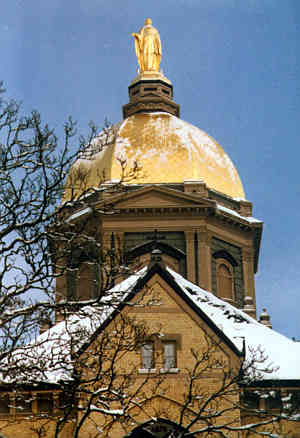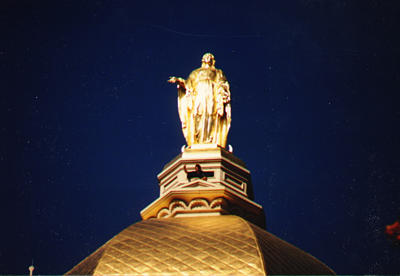
Notre Dame's Grotto / by Dorothy V. Corson


Raising the Statue to the Dome
The work of raising the statue to its present position was skillfully accomplished by Mr. Alexander Staples, of standpipe fame,(77) who engineered putting it on the Dome. It took two days. The 1879, Scholastic published a description of the statue:
We have received a description of the proposed statue of our Lady which is to adorn the new University, and which the young lady graduates(78) of St. Mary's Academy generously proposed themselves to contribute as their crowning gift to Notre Dame. The model of the statue is that adopted by our late Holy Father, Pope Pius IX, in 1854, on the occasion of the solemn proclamation of the dogma of the Immaculate Conception (erected by Pius IX in front of the Propaganda College in Piazza di Spagna in Rome). The material will be of highly polished bronze, sixteen feet in height, the crescent with the serpent beneath, and a starry crown above. Nine of the stars will be seen over and on either side of the head. By day the statue itself and its circle of stars will glitter in the sunlight, an object of beauty for miles around; and by night the nine stars will be lit with the electric light, and thus be a beacon of beauty from a still further distance. As the head will be 186 feet above the earth [sources vary on this; 197 feet seems to be the correct figure],(79) it is evident that the jets of light will be seen by night all over the neighboring city and for a great distance on the various railroads entering here.
The young ladies of St. Mary's have therefore undertaken a beautiful task, a labor of love, in thus placing our Lady's statue in mid-air, as Michael Angelo placed the faultless Grecian temple above St. Peter's, a thing of beauty to rest and shine there, a joy forever. May their labor of love be rewarded, here, with the success of the object which they have in view, and afterwards with the sweet memory of the noble deed which they have accomplished, and may our Blessed Lady look upon them with her brightest smiles when, as the shades of night come on, her beautiful statue lights up the landscape of Notre Dame and St. Mary's!(80)
Marion McCandless in her book, Family Portraits, reports on this project which was proposed the same year the St. Mary's Alumnae Association was founded, in 1879. She then mentions the fact that this first project proposed by them was accomplished only in part by the alumnae.(81) It is not clear from surviving records if others at St. Mary's made up the difference or whether Sorin obtained the rest from other sources.
Tom Schlereth in his book, A Dome of Learning , states that it was "purchased largely from bequests from Mother Angela Gillespie's Holy Cross sisters, women students and alumnae of Saint Mary's Academy."(82)
Another source seems to validate Schlereth's statement:
Mother Angela sent a circular letter to the Sisters commanding, not requesting, each of them to raise twenty dollars toward the restoration of the main building at Notre Dame. Gifts poured in from friends, alumni, merchants, other educators, benefactors of all ages, places of residence, and economic levels. The Saint Mary's Academy alumnae officers began collecting funds to put a bigger statue on a bigger dome. The new building opened on time in September, not complete, but usable.(83)
In 1883, the Scholastic described in detail the placing of the statue on the Dome:
The great event of the past week was the placing of the colossal statue of the Blessed Virgin on the Dome of the University. . . . As announced in the Scholastic, a short time ago, the exterior work of the Dome was finished, and everything was ready for the statue. On last Monday afternoon, the statue was lowered from the front porch and brought to the rear of the College. There it was allowed to remain until the apparatus necessary for raising it to the summit of the Dome could be prepared. Everything was ready by Wednesday noon and that afternoon, slowly but surely, the grand figure ascended to the roof of the College. On Thursday work was resumed, and at length, at five o'clock p.m., amid the ringing of bells, the statue was seen to rest firmly and securely on its grand pedestal.
The statue is the work of the late Mr. Giovanni Meli, of Chicago, and is the largest of its kind in the United States. It stands sixteen feet in height and weights 4,400 lbs.
"The statue is on the Dome!" was the general exclamation, last Thursday night. Few and simple were the words, yet they contained a wealth of meaning. They announced the accomplishment of long-cherished desires of the heart, the filling up of a void long too open at Notre Dame, the crowning act in the public expression of honor to her under whose patronage this Home of Religion and Science is placed.
Notre Dame -- "Our Lady." These two short words speak volumes in explanation and praise of the motive which has led to the erection of this glorious monument to the Mother of God . . . . More than three years have glided by since Notre Dame passed through its fiery ordeal, and the time was well employed in preparing for the erection of a monument which would be, as far as loving hearts and willing hands could make it, a fitting expression of gratitude, and the most glorious of its kind in the country.
And now these desires are realized. Today this grand statue, so familiar to the visitor and student at Notre Dame, stands upon her magnificent throne, and, with extended arms, gives the assurance of the continued protection of her whom it represents.(84)
The golden dome was finished on September 26, 1883. The following month the statue of Our Lady . . . was hoisted, on a trough by block and tackle, to its throne 207 feet above the earth. One year later her crown and crescent were electrically illuminated thus making Notre Dame the first college to use such lights. Edison had discovered the incandescent globe on October 21, 1879 after spending two years testing over 6,000 substances and spending $100,000 in search of the proper filament. It is said that the Notre Dame statue of Our Lady became also the first airplane beacon light visible in five states.(85)
A picture of the "circle of electric lights crowning her head and the moon at her feet" appeared in the first Notre Dame yearbook, the 1906 Dome. A poem from the same era describes Our Lady's crown and crescent, "emblazoned in a halo of Electric Glory."
| Night comes and sets thy beacon in the skies A woman starry-crowned, with starry eyes, That watch forever with a solace meet, Above the glimmering moon beneath her feet.(86) |
When floodlights were introduced that would adequately illuminate the statue, the crown and crescent were removed, and Our Lady was forever to be seen as she is today, aglow with light.
